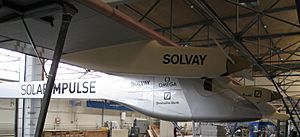Solar Impulse facts for kids
Solar Impulse is the name of an amazing Swiss project and two special airplanes. These planes are powered only by the sun! The project was started by a Swiss engineer and businessman named André Borschberg and a Swiss doctor and balloonist named Bertrand Piccard. Bertrand Piccard was also part of the team that flew a balloon around the world without stopping.
The main goal of the Solar Impulse project was to fly an airplane around the Earth using only solar power. They also wanted to show everyone how important clean technologies are for our planet.
Contents
What is Solar Impulse?
The Solar Impulse planes are designed to carry just one pilot. They are called monoplanes because they have one main wing. These planes get all their power from solar cells (also called photovoltaic cells) on their wings. These cells turn sunlight into electricity, which powers the plane's motors. This means the plane can take off and fly using only the sun's energy.
Solar Impulse 1: The First Steps
The first plane, called Solar Impulse 1, was built to stay in the air for up to 36 hours. This was important because it needed to fly through the night when there was no sun.
- First Flight: It made its very first test flight in December 2009.
- Night Flight: In July 2010, it flew for 26 hours straight. This included almost nine hours of flying at night, proving it could store enough energy from the sun to keep going in the dark.
- Longer Journeys: In 2012, Piccard and Borschberg flew Solar Impulse 1 from Switzerland to Spain and then to Morocco.
- Across America: In 2013, they completed a flight across the United States, stopping in different cities along the way.
Solar Impulse 2: Around the World
A second, improved airplane, named Solar Impulse 2, was finished in 2014. It had more solar cells and stronger motors than the first plane.
- Starting the Journey: On March 9, 2015, Bertrand Piccard and André Borschberg began their journey to fly Solar Impulse 2 around the world. They started in Abu Dhabi, a city in the United Arab Emirates.
- Crossing Continents: By June 2015, the plane had flown across Asia.
- Longest Flight: In July 2015, it completed the longest part of its trip, flying from Japan all the way to Hawaii. This was a very challenging flight!
- Repairs: During the flight to Hawaii, the plane's batteries got too hot and were damaged. It took many months to fix them.
- Resuming the Flight: Solar Impulse 2 started flying again in April 2016, heading to California. It continued across the United States, reaching New York City in June 2016.
- Across the Atlantic: Later that same month, the plane successfully flew across the Atlantic Ocean to Spain.
- Finishing the Trip: After stopping in Egypt, Solar Impulse 2 returned to Abu Dhabi on July 26, 2016. It had been more than 16 months since it started! The plane traveled about 42,000 kilometers (26,000 miles) and completed the first flight around the Earth using only solar power.
Images for kids
-
Solar Impulse 1 during its first "flea hop" test flight in Dübendorf on December 3, 2009
-
Solar Impulse 1 at Brussels Airport in May 2011.
-
Solar Impulse 1 on display at John F. Kennedy International Airport, New York, on July 14, 2013.
See also
 In Spanish: Solar Impulse para niños
In Spanish: Solar Impulse para niños









